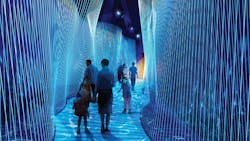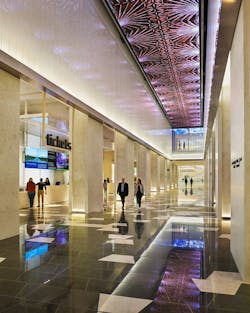By Brian Ensign, Superior Essex
By combining the oldest book in the world with future-forward communications technology, the Museum of the Bible in Washington D.C. has created a multicultural experience of immersive environments, interactive exhibits and rare artifacts. And to keep it all connected, the museum trusted Superior Essex to deliver numerous high-quality, reliable cabling solutions for voice, data, Power over Ethernet, and complex audio-visual (AV) applications—all working together to captivate generations of believers for decades to come.
Defunct warehouse to high-tech museum
Located just three blocks from the United States Capitol in the heart of Washington D.C., and surrounded by the city’s numerous downtown attractions, the 430,000-square-foot Museum of the Bible was five years in the making from initial design work to its grand opening in November 2017. The structure originally was constructed in 1922 as a refrigerated warehouse. But the museum’s leadership and partners—including Superior Essex and Legrand—have repurposed the old, 8-story brick building and transformed it into a technological spectacle that encompasses high-tech displays, theme-park-style interactive exhibits, expansive theaters, thousands of artifacts and generous event spaces. All these attractions work together to draw visitors—believer and secular alike—from across different countries and cultures to experience the Bible’s impact on the modern world.
In total, the museum represents a massive investment of more than $500 million and includes such technology as interactive touch screens; LED video walls; a 360-degree panoramic theater with seating for more than 450 visitors, along with other smaller theaters; a simulated virtual ride through D.C.; 40 separate, unique exhibits; a proprietary, personalized, indoor digital navigation system; a gaming system; virtual reality “living” scenes; a rooftop restaurant; and numerous connected classrooms.
This myriad of applications converging onto a common network required a technological infrastructure that could deliver both data and power throughout this facility to create a truly integrated smart building. That’s why the museum partnered with systems integrator S2N Technology Group, LLC to review the technology requirements and design each exhibit’s low-voltage application; communications cable manufacturer Superior Essex to deliver the fiber and copper cabling solutions; and Legrand to supply the cable management and connectivity in the telecommunications and AV equipment rooms.
A smart building for the “Greatest Story Ever Told”
Smart buildings, supported by an intelligent infrastructure solution, ultimately reduce operational costs, enhance performance and allow for future adaptability. And with the hundreds of different applications and devices, miles of various cable runs and the vast array of digital equipment required to make these complex integrations and sophisticated control systems possible—as well as run on a single, converged network—creating a smart building of this capacity required a comprehensive plan.
The museum’s 40 exhibits, each meant to communicate aspects of biblical stories in assorted media such as AV projections and interactive applications, were created by four different exhibit designers. Furthermore, “All of the exhibits’ designs for low-voltage applications, including the ceiling pathways and massive media walls, were not included in the base design of the building,” explained Ian Mitchell, RCDD, RTPM, LEED AP, senior project manager for systems integration at S2N. “So we had to coordinate with the specific application vendors and museum designers to review any constraints and come up with solutions.”
In the process, S2N collected all the design information from each exhibitor and laid out the infrastructure design—which included mapping out the different pathways and choosing the backbone and horizontal cable, telecom room equipment and termination components. They also engaged with Network Products Inc. (NPI), a manufacturer representative for both Superior Essex and Legrand, to specify and supply the cable necessary to connect these complex, networked AV systems, including massive displays such as the 40-foot-tall lobby screen with LED panels measuring 125 feet long by 30 feet wide, an intricate digital mapping system, and a complex acoustic enhancement system in the immense 8000-square-foot World Stage Theater with seating for 450 visitors.“We hosted the technology and network teams from S2N and the Museum of the Bible at our showroom in Maryland to give them hands-on demonstrations of the products selected for the jobsite,” said Jon Mengenhauser, owner of NPI.
Throughout the fast-tracked construction schedule of just under two years, S2N worked with Superior Essex and Legrand to design and equip more than 20 telecom rooms and AV rooms that housed all the active equipment and termination components for every application connected by the structured cabling, as well as to each individual exhibit. By the time of completion, Net100 Ltd., the selected low-voltage contractor, had spent more than 26,000 hours installing more than 735,000 feet of Superior Essex fiber and copper cables to provide data, voice, power (via PoE), and AV to more than 2200 devices all over the museum.
Cable that connects the masses
With highly sophisticated technology spread throughout the museum and unique architectural forms on every floor and in every exhibit, the teams faced numerous, interesting challenges getting it all connected. Five challenges in particular stood out.
Coordinating the pathways for horizontal cables to reach and serve all the applications in their unique locations. “There were lots of hard ceilings that were dry-walled, which made it difficult for planning the cable runs,” stated Matt Odell, director of technologies at S2N. “So we creatively located pull boxes connected with 4-inch conduit in these locations, mainly for AV applications, and these had to be carefully planned before the ceiling was closed.”
On a couple of the exhibit floors, the ceilings were open air, so cable trays or J-hooks were installed. Where applicable, Net100—the installation team—ran horizontal cable through low-profile, 2-inch raised floors.
“Our infrastructure design reflects a concerted effort between S2N and our vendors,” stated Odell. Mitchell added, “Working with Superior Essex, our project team was able to turn many cabling challenges into solutions.”
Brick construction. The original building was constructed with brick, making it difficult to design the backbone cabling infrastructure from the telecom and AV rooms, while also connecting it with the network of an adjacent hotel building and performance hall, and tying it all back to the main demarcation point and server room located in the building’s basement.
The selection of the backbone cable had to provide enough bandwidth for today’s and tomorrow’s communications needs, so Superior Essex provided 12 strands of both OM3 multimode and OS2 singlemode optical fiber cable as the backbone between floors and to the telecom and AV rooms. The fiber cable was mechanically spliced and terminated with Legrand MightyMo 20-fiber splice cabinets. Additionally, Superior Essex supplied the Category 3 cable required to create a copper backbone for analog phones.
“Although we had to be creative with the locations and varying capacities of the telecom and AV rooms per floor, we set a standard for the copper and fiber cable and termination productions,” explained Mitchell. “We wanted to be consistent with the design and the installed cabling products.”
Large indoor and outdoor displays requiring sophisticated pathways and cabling. Providing cables to displays located both inside and outside the museum, especially to those located on windows and ceilings, was a challenge because of the high ground as well as the stone floor. The design for connectivity to the AV displays went through several iterations, and the biggest challenge was creating the pathways from the telecom and AV rooms to the individual LED panels. Because most of the ceilings were hard-plastered, time was of the essence to run and terminate the cable before the ceilings were closed.
To solve this, Net100 pulled Superior Essex OM3 6-strand plenum armored optical fiber cable through 4-inch conduits from AV and IT rooms to accessible fiber boxes. They then terminated two strands of Superior Essex OM3 cable to each LED panel. As a result, all these displays and devices work seamlessly together, with both the data and power service they require.Digital mapping system. The building’s complex digital mapping system provides personalized indoor navigation that can track users within 6 inches to guide them to their preset, programmed schedule. A digital docent (handheld tablet) enables the step-by-step navigation system, but it needed to remain connected to the network at all times to operate properly.
The system uses an ultrawideband technology to detect the position of every digital docent holder. The 600 anchor points installed in the ceiling and throughout the exhibit spaces allow users to be in close proximity with each other but not experience any cross-communication. Each anchor requires 900 MHz of data, and Superior Essex supplied the Category 6 cable to provide both Power over Ethernet and data to each anchor. The anchors’ robust signals can transmit through concrete walls.
The 8000-square-foot theater. An AV wonder, the museum’s theater uses a digital 3D-mapping technique to transform into an immersive experience that brings the audience into the production unfolding around them. Achieving this experience requires 17 floor-to-ceiling, high-output 4K projectors that seamlessly weave the digital images and an acoustic enhancement sound system programmed to suit the nature of the event and correspond to video. These devices all need to be interconnected to work together flawlessly.
The cable pathways in the theater are a combination of free air and conduit from two dedicated telecom and AV rooms serving this grand theater. Superior Essex provided the OM3 multimode fiber-optic cable and the Category 6 copper cable to supply each of the 17 projectors. In addition, Superior Essex Category 6 copper cable connected each of the projector sensors.
The installation team also pulled additional runs of Superior Essex optical fiber cable for broadcast cameras located in the theater to provide connections to the media when needed for special events. The Museum of the Bible features the world’s largest virtual theater.
In total, more than 140 miles of Superior Essex copper and fiber cable products now interconnect the various devices throughout the Museum of the Bible. The six main cabling solutions were:
- 202,000 feet of Superior Essex multimode 50-micron OM3 fiber-optic cables (2-, 6-, 12-, 24-, 48-strand; plenum-armored and interconnect)
- 15,360 feet of Superior Essex singlemode fiber-optic cables (6-, 12-, 24-, and 48-strand; plenum-armored, bend-insensitive)
- 166,000 feet of Superior Essex 4-pair Category 6A cable
- 328,000 feet of Superior Essex 4-pair Category 6 cable
- 6,650 feet of Superior Essex 25-pair and 100-pair Category 3 cable
- 5,000 feet of Superior Essex quad-shield plenum RG-6 coaxial cable
Building a masterpiece for all time
Designed to adjust constantly to changes and incorporate future exhibits, whether through vide or stationary presentations, the Museum of the Bible is as adaptable as its network infrastructure. Everything in this museum strives to provide an immersive experience through the use of numerous future-forward technologies. As a result, the museum’s converged communications infrastructure consolidates all the data, power, AV and media-storage traffic onto a single, high-performance, highly available network.
This common infrastructure, in turn, simplifies the installation path for addition any new applications. It acts as the unifier that ties all of the technology together to ensure an integrated performance that enables consistent, high-quality experiences for today, tomorrow and generations to come. And when the exhibits get changed out or updated, the future-forward cabling from Superior Essex is specifically designed to quietly withstand the tests of time from behind the walls, seamlessly providing application assurance and an unforgettable experience for the museum and every one of its visitors.
Brian Ensign is vice president of marketing for Superior Essex.

